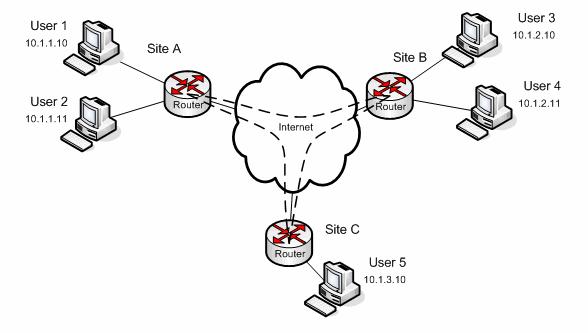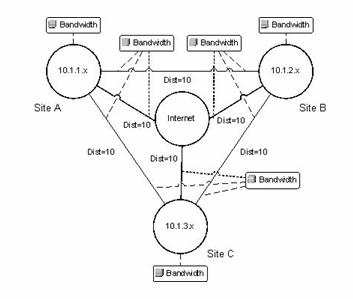Example 3: Virtual circuits between sites
Illustration of a network, managed by IBM® Sametime® Bandwidth Manager, that uses virtual circuits (for example, using frame relay, ATM, or VPN technology). In this example, multiple virtual circuits can share the same physical link.
A typical scenario consists of a number of sites (buildings or campus locations) connected through virtual circuits that are routed through any-to-any clouds, as shown in the following figure:

In this scenario multiple VPN circuits may use the same physical access circuit (for example, a connection to the internet). When modeling VPN circuits, you must do the following:
- Model the physical links that will carry the VPN circuits. In this example, you must model three physical circuits—one for each site—to the Internet. These physical links will have bandwidth pools associated with them that model the capacity of the physical circuits.
- Model the VPN links between the various sites as you would any other link between sites. Since they are virtual links, these links do not have any bandwidth constraints of their own; instead they inherit the bandwidth constraints of the physical links they're associated with. Administrators model this association by indicating which physical link is used to carry the virtual link.
In summary, the bandwidth constraint of the shared access line is modeled by a single bandwidth pool that is shared by multiple virtual circuits as shown in the following diagram:

Setting the nominal VPN link capacity
In addition to modeling the physical constraints of access links, you may also want to separately constrain how much bandwidth each individual VPN link can use. This prevents any one VPN link from using all of the physical link's capacity and starving the other VPN links sharing the same circuit. You can set this restriction by specifying the “nominal” VPN link capacity as a percentage of the maximum capacity of the physical link. For example, nominal VPN link capacity may be 80% of the physical capacity, meaning that at least 20% of the physical link capacity is available for other VPN links. By default, the nominal link capacity for all VPN links will be set to 100%, meaning there is no restriction on how much physical bandwidth any one VPN link can use.